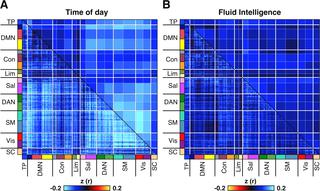当前位置:
X-MOL 学术
›
PLOS Biol.
›
论文详情
Our official English website, www.x-mol.net, welcomes your feedback! (Note: you will need to create a separate account there.)
Time of day is associated with paradoxical reductions in global signal fluctuation and functional connectivity.
PLOS Biology ( IF 9.8 ) Pub Date : 2020-02-18 , DOI: 10.1371/journal.pbio.3000602 Csaba Orban 1, 2, 3, 4 , Ru Kong 1, 2, 3 , Jingwei Li 1, 2, 3 , Michael W L Chee 2, 3, 5, 6 , B T Thomas Yeo 1, 2, 3, 5, 6, 7
PLOS Biology ( IF 9.8 ) Pub Date : 2020-02-18 , DOI: 10.1371/journal.pbio.3000602 Csaba Orban 1, 2, 3, 4 , Ru Kong 1, 2, 3 , Jingwei Li 1, 2, 3 , Michael W L Chee 2, 3, 5, 6 , B T Thomas Yeo 1, 2, 3, 5, 6, 7
Affiliation

|
The brain exhibits substantial diurnal variation in physiology and function, but neuroscience studies rarely report or consider the effects of time of day. Here, we examined variation in resting-state functional MRI (fMRI) in around 900 individuals scanned between 8 AM and 10 PM on two different days. Multiple studies across animals and humans have demonstrated that the brain's global signal (GS) amplitude (henceforth referred to as "fluctuation") increases with decreased arousal. Thus, in accord with known circadian variation in arousal, we hypothesised that GS fluctuation would be lowest in the morning, increase in the midafternoon, and dip in the early evening. Instead, we observed a cumulative decrease in GS fluctuation as the day progressed. Although respiratory variation also decreased with time of day, control analyses suggested that this did not account for the reduction in GS fluctuation. Finally, time of day was associated with marked decreases in resting-state functional connectivity across the whole brain. The magnitude of decrease was significantly stronger than associations between functional connectivity and behaviour (e.g., fluid intelligence). These findings reveal time of day effects on global brain activity that are not easily explained by expected arousal state or physiological artefacts. We conclude by discussing potential mechanisms for the observed diurnal variation in resting brain activity and the importance of accounting for time of day in future studies.
中文翻译:

一天中的时间与总体信号波动和功能连接性的反常减少有关。
大脑在生理和功能上表现出很大的昼夜变化,但是神经科学研究很少报告或考虑一天中的时间影响。在这里,我们检查了大约两天不同时间在上午8点至晚上10点之间扫描的约900个人的静止状态功能MRI(fMRI)的变化。对动物和人类的多项研究表明,大脑的整体信号(GS)振幅(以下称为“波动”)随着唤醒的减少而增加。因此,根据已知的昼夜节律变化,我们假设GS波动在早晨最低,在午后增加,在傍晚下降。相反,我们观察到随着一天的进展,GS波动的累积减少。尽管呼吸变化随一天的时间而减少,对照分析表明,这并未说明GS波动的减少。最后,一天中的时间与整个大脑的静止状态功能连接性显着降低有关。下降的幅度明显强于功能连接性和行为(例如,流体智能)之间的关联。这些发现揭示了一天中对全球脑部活动的影响,这很难通过预期的唤醒状态或生理伪像来解释。我们通过讨论在静息大脑活动中观察到的昼夜变化的潜在机制以及在以后的研究中考虑一天中的时间的重要性来得出结论。一天中的时间与整个大脑的静止状态功能连接性显着降低有关。下降的幅度明显强于功能连接性和行为(例如,流体智能)之间的关联。这些发现揭示了一天中对全球脑部活动的影响,这很难通过预期的唤醒状态或生理伪像来解释。我们通过讨论在静息大脑活动中观察到的昼夜变化的潜在机制以及在以后的研究中考虑一天中的时间的重要性来得出结论。一天中的时间与整个大脑的静止状态功能连接性显着降低有关。下降的幅度明显强于功能连接性和行为(例如,流体智能)之间的关联。这些发现揭示了一天中对全球脑部活动的影响,这很难通过预期的唤醒状态或生理伪像来解释。我们通过讨论在静息大脑活动中观察到的昼夜变化的潜在机制以及在以后的研究中考虑一天中的时间的重要性来得出结论。这些发现揭示了一天中对全球脑部活动的影响,这很难通过预期的唤醒状态或生理伪像来解释。我们通过讨论在静息大脑活动中观察到的昼夜变化的潜在机制以及在以后的研究中考虑一天中的时间的重要性来得出结论。这些发现揭示了一天中对全球脑部活动的影响,这很难通过预期的唤醒状态或生理伪像来解释。我们通过讨论在静息大脑活动中观察到的昼夜变化的潜在机制以及在以后的研究中考虑一天中的时间的重要性来得出结论。
更新日期:2020-03-02
中文翻译:

一天中的时间与总体信号波动和功能连接性的反常减少有关。
大脑在生理和功能上表现出很大的昼夜变化,但是神经科学研究很少报告或考虑一天中的时间影响。在这里,我们检查了大约两天不同时间在上午8点至晚上10点之间扫描的约900个人的静止状态功能MRI(fMRI)的变化。对动物和人类的多项研究表明,大脑的整体信号(GS)振幅(以下称为“波动”)随着唤醒的减少而增加。因此,根据已知的昼夜节律变化,我们假设GS波动在早晨最低,在午后增加,在傍晚下降。相反,我们观察到随着一天的进展,GS波动的累积减少。尽管呼吸变化随一天的时间而减少,对照分析表明,这并未说明GS波动的减少。最后,一天中的时间与整个大脑的静止状态功能连接性显着降低有关。下降的幅度明显强于功能连接性和行为(例如,流体智能)之间的关联。这些发现揭示了一天中对全球脑部活动的影响,这很难通过预期的唤醒状态或生理伪像来解释。我们通过讨论在静息大脑活动中观察到的昼夜变化的潜在机制以及在以后的研究中考虑一天中的时间的重要性来得出结论。一天中的时间与整个大脑的静止状态功能连接性显着降低有关。下降的幅度明显强于功能连接性和行为(例如,流体智能)之间的关联。这些发现揭示了一天中对全球脑部活动的影响,这很难通过预期的唤醒状态或生理伪像来解释。我们通过讨论在静息大脑活动中观察到的昼夜变化的潜在机制以及在以后的研究中考虑一天中的时间的重要性来得出结论。一天中的时间与整个大脑的静止状态功能连接性显着降低有关。下降的幅度明显强于功能连接性和行为(例如,流体智能)之间的关联。这些发现揭示了一天中对全球脑部活动的影响,这很难通过预期的唤醒状态或生理伪像来解释。我们通过讨论在静息大脑活动中观察到的昼夜变化的潜在机制以及在以后的研究中考虑一天中的时间的重要性来得出结论。这些发现揭示了一天中对全球脑部活动的影响,这很难通过预期的唤醒状态或生理伪像来解释。我们通过讨论在静息大脑活动中观察到的昼夜变化的潜在机制以及在以后的研究中考虑一天中的时间的重要性来得出结论。这些发现揭示了一天中对全球脑部活动的影响,这很难通过预期的唤醒状态或生理伪像来解释。我们通过讨论在静息大脑活动中观察到的昼夜变化的潜在机制以及在以后的研究中考虑一天中的时间的重要性来得出结论。



























 京公网安备 11010802027423号
京公网安备 11010802027423号